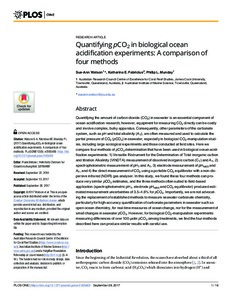Quantifying pCO2 in biological ocean acidification experiments: a comparison of four methods.

View/
Average rating
votes
Date
2017Author
Watson, Sue-Ann
Fabricius, Katharina E.
Munday, Philip L.
Metadata
Show full item recordAbstract
Quantifying the amount of carbon dioxide (CO2) in seawater is an essential component of
ocean acidification research; however, equipment for measuring CO2 directly can be costly
and involve complex, bulky apparatus. Consequently, other parameters of the carbonate
system, such as pH and total alkalinity (AT), are often measured and used to calculate the
partial pressure of CO2 (pCO2) in seawater, especially in biological CO2-manipulation studies,
including large ecological experiments and those conducted at field sites. Here we
compare four methods of pCO2 determination that have been used in biological ocean acidification
experiments: 1) Versatile INstrument for the Determination of Total inorganic carbon
and titration Alkalinity (VINDTA) measurement of dissolved inorganic carbon (CT) and AT, 2)
spectrophotometric measurement of pHT and AT, 3) electrode measurement of pHNBS and
AT, and 4) the direct measurement of CO2 using a portable CO2 equilibrator with a non-dispersive
i.....
Journal
PLOS OneVolume
12ttps://doi. org/10.1371/journal.pone.0185469Issue
Article e0185469Page Range
16pp.Document Language
enSustainable Development Goals (SDG)
14.3Essential Ocean Variables (EOV)
Inorganic carbonMaturity Level
TRL 8 Actual system completed and "mission qualified" through test and demonstration in an operational environment (ground or space)Best Practice Type
Manual (incl. handbook, guide, cookbook etc)Standard Operating Procedure
DOI Original
10.1371/journal.pone.0185469Citation
Watson, S-A.; Fabricius, K.E. and Munday, P.L. (2017) Quantifying pCO2 in biological ocean acidification experiments: A comparison of four methods. PLoS ONE 12 e0185469, 16pp. DOI: https://doi. org/10.1371/journal.pone.0185469Collections
The following license files are associated with this item:
 Repository of community practices in Ocean Research, Applications and Data/Information Management
Repository of community practices in Ocean Research, Applications and Data/Information Management
